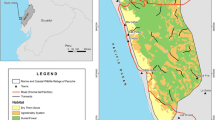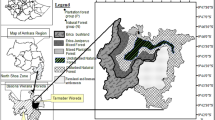Abstract
The black-faced black spider monkey (Ateles chamek) is endangered because of hunting and habitat loss. There are many gaps in our understanding of its geographic distribution. The Ucayali–Solimões–Amazon fluvial complex is currently recognized as the northern boundary of the species’ range, although published reports have indicated that it occurs north of the Rio Solimões. In this study we investigate published records, generate new field records, and assess the current information concerning the northern boundary of this species’ range. We conducted the study at the Mamirauá Sustainable Development Reserve in the central Brazilian Amazon, an area of 1,124,000 ha that consists entirely of Amazonian flooded forest (várzea). We collected data on the occurrence of the species from museum specimens and through field surveys, including interviews with local residents, direct observations, and the collection of new museum specimens. We confirmed the presence of A. chamek at 17 locations in the reserve, one of which was an island formed by a river bend cut-off that would have effectively taken any resident spider to the (new) north bank of the Solimões. We therefore conclude that fluvial dynamics were involved in creating the conditions for the dispersal and colonization of the species on the northern bank of the Rio Solimões. The data we present extends the known distribution of the species and increases its representation in protected areas.

Similar content being viewed by others
References
Almeida FB, Deane LM (1970) Plasmodium brasilianum reencontrado em seu hospedeiro original, o macaco uacari-branco, Cacajao calvus. Bol INPA/Patol Trop 4:1–9
Ayres JM, Clutton-Brock TH (1992) River boundaries and species range size in Amazonian primates. Am Nat 140:531–537
Ayres JM, Fonseca GAB da, Rylands AB, Queiroz HL, Pinto LP de S, Masterson D, Cavalcanti RB (2005) Os Corredores Ecológicos das Florestas Tropicais do Brasil. Sociedade Civil Mamirauá, Belém
Barnett AA, Borges SH, Castilho CV, Neri FM, Shapley RL (2002) Primates of the Jaú National Park, Amazonas, Brazil. Neotrop Primates 10:65–70
Chaves OM, Stoner KE (2010) River crossings by Ateles geoffroyi and Alouatta pigra in southern Mexico: a preliminary report. Rev Chil Hist Nat 83:435–442
Collins AC, Dubach JM (2000) Biogeographic and ecological forces responsible for speciation in Ateles. Int J Primatol 21:421–444
Emmons LH, Feer F (1997) Neotropical rainforest mammals: a field guide, 2ª edn. University of Chicago Press, Chicago
Goldani A, Carvalho GS, Bicca-Marques JC (2006) Distribution patterns of neotropical primates (Platyrrhini) based on parsimony analysis of endemicity. Braz J Biol 66:61–74
IUCN (2012) IUCN Red List of Threatened Species, Version 2012.2. http://www.iucnredlist.org. Accessed 2 April 2013
Kellogg R, Goldman EA (1944) Review of the spider monkeys. Proc US Nat Mus 96:1–45
Konstant W, Mittermeier RA, Nash SD (1985) Spider monkeys in captivity and in the wild. Primate Conserv 5:82–109
Kunkel LM, Heltne PG, Borgaonkar DS (1980) Chromosomal variation and zoogeography in Ateles. Int J Primatol 1:223–232
Osterkamp WR (1998) Processes on fluvial island formation, with examples from Plum Creek, Colorado and Snake River, Idaho. Wetlands 18:530–545
Peixoto JMA (2007) Monitoramento da dinâmica da geomorfologia fluvial da Reserva de Desenvolvimento Sustentável Mamirauá por meio de técnicas de sensoriamento remoto. Master’s Dissertation. Instituto Nacional de Pesquisas da Amazônia/Universidade Federal do Amazonas, Manaus
Peixoto JMA, Nelson BW, Wittmann F (2009) Spatial and temporal dynamics of river channel migration and vegetation in central Amazonian white-water floodplains by remote-sensing techniques. Remote Sens Environ 113:2258–2266
Projeto RADAMBRASIL (1977) Levantamento dos recursos naturais. Folha SA 20 Manaus. vol 18. Ministério de Minas e Energia, Rio de Janeiro
Puhakka M, Kalliola R, Rajasilta M, Salo J (1992) River types, site evolution and successional vegetation patterns in Peruvian Amazonia. J Biogeogr 19:651–665
Rumiz DI, Eulert CF, Arispe R (1998) Assessing diversity of large and medium size mammals in the Carrasco National Park. Rev Bol de Ecol 4:77–90
Rylands AB, Bernardes AT (1989) Two priority regions for primate conservation in the Brazilian Amazon. Primate Conserv 10:56–62
Spironello WR, Noronha M (2005) Relatório da II expedição científica—levantamento de mamíferos não-voadores de médio e grande porte. Instituto Brasileiro do Meio Ambiente e dos Recursos Naturais Renováveis. Diretoria de Ecossistemas/Coordenação Geral de Unidades de Conservação/Gerência Executiva do Estado do Amazonas. Núcleo de Unidades de Conservação—Estação Ecológica Juami-Japurá
Valsecchi J (2005) Diversidade de mamíferos e uso da fauna nas Reservas de Desenvolvimento Sustentável Mamirauá e Amanã—Amazonas—Brasil. Master’s Dissertation. Museu Paraense Emilio Goeldi/Universidade Federal do Pará, Belém
Wallace RB, Mittermeier RA, Cornejo F, Boubli JP (2008) Ateles chamek. In: IUCN 2012. IUCN Red List of Threatened Species. Version 2012.2. http://www.iucnredlist.org. Accessed 2 April 2013
Acknowledgments
This research was funded by the Instituto de Desenvolvimento Sustentável Mamirauá (IDSM-OS/MCTI). We thank Mamédio Lopes, Mário Carvalho, Antônio Magalhães, and Geremias Alves for their assistance in the fieldwork, and all the kindness and willingness of the interviewees in the local communities. We thank the Infrastructure and Logistics Team at the Instituto de Desenvolvimento Sustentável Mamirauá and the Maraã Municipal Environment Department for supporting our field activities, and Graciete Rolim for assistance in obtaining old publications. We also thank two anonymous reviewers for their suggestions and revisions, which substantially improved the manuscript, and Karl Didier and Anthony Rylands for a final English revision.
Author information
Authors and Affiliations
Corresponding author
About this article
Cite this article
Rabelo, R.M., Silva, F.E., Vieira, T. et al. Extension of the geographic range of Ateles chamek (Primates, Atelidae): evidence of river-barrier crossing by an amazonian primate. Primates 55, 167–171 (2014). https://doi.org/10.1007/s10329-014-0409-3
Received:
Accepted:
Published:
Issue Date:
DOI: https://doi.org/10.1007/s10329-014-0409-3




